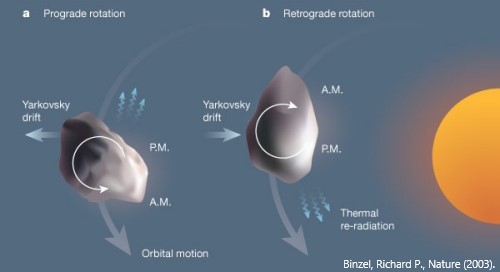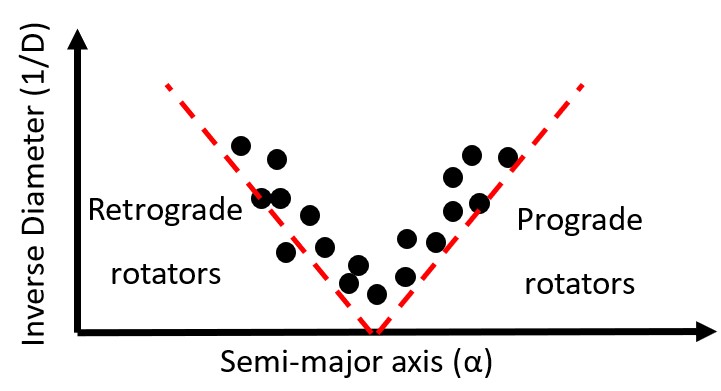Asteroids
Asteroids are minor planets of the inner Solar System, including those co-orbitals with Jupiter. They have irregular shapes with sizes between a few meters and several hundred kilometers and are diverse in composition. The large asteroids (with diameter larger than 50 − 100 km) are the most likely to be "pristine", because they were not generated in large numbers in collisional breakup events of larger parent bodies. For this reason, they are considered as planetesimals remained relatively unchanged since their formation. Some asteroids belong to asteroid families, that came from larger parent bodies which were shattered in past collisions with other bodies. The collisional process drives the re-accumulation of the fragments to form rubble piles, asteroids consisting of numerous pieces of boulders and rocks that have coalesced under the influence of gravity.
Asteroid Collisional FamiliesAn asteroid collisional family is a group of collisional fragments that formed from cratering or the disruption of the parent asteroid that was broken by an impact. Asteroid family members have in general similar orbits and spectra. The asteroid belt has collisionally evolved since its formation, creating a large number of collisional fragments. The collision rate among main belt asteroids is assumed to be relatively constant during the last ~4 Gyr, however the most known asteroid families have ages less than ~2 Gyr. About 25% of discovered asteroids has been associated with more than 100 known asteroid families. The identification of collisional families would determine the original planetesimal population, revealing their size distribution. Such a classification of the asteroids is the key for the understanding of the dynamical and the collisional evolution of the asteroid population and the correlation between of them.
The Yarkovsky effect is a thermal radiation force that acts on small solar system bodies
The Yarkovsky effect disperses the asteroid members of families
The insolation heats up the sunward side of the asteroid and the heat is radiated back into space. The latter is observable usually in the infrared part of the spectrum. Each photon carries away a momentum depending on its energy (i.e., its wavelength). So, more energy and therefore more momentum is released by the hotter part of the body than the colder, causing a net kick to the asteroid in the opposite direction of its hotter part. The asteroids emit thermal radiation with a delay, due to their thermal inertia. While, the hottest part of their surface is their afternoon side rather than the subsolar point. If the asteroid has a prograde rotation, then the direction of the thermal force is opposite to the orbital motion and drives the body to higher heliocentric distances. On the other hand, if the asteroid has a retrograde rotation, then its orbit is shrinking. This is also known as Yarkovsky diurnal effect, when the spin axis of the body is not on its orbital plane. This effect slowly changes asteroids’ orbital semimajor axis a at a rate da/dt proportional to the inverse of its diameter D, 1/D. Prograde rotating asteroids have da/dt>0 and move to higher heliocentric distances, retrograde ones with da/dt<0 move to lower. For members of an asteroid family created by an impact at a certain orbital semimajor axis aC, the Yarkovsky effect creates correlations of points in the 1/D vs a plane called V-shapes, as they resemble the letter "V", whose slope indicates family age and its vertex is roughly at aC The wider the V-shape extends, the older the family is.
Identification of the oldest asteroid collisional families
The discovery of the oldest asteroid collisional families has been done by Dr. Marco Delbo et al., using an unconventional family identification method that looks for correlation
between the orbital position and the size of asteroids.
Namely the smaller an asteroid is the furthest is from the centre of the family (a plot of the asteroid density in the
inverse diameter (1/D) vs semimajor axis (a) plane makes the so-called "V-shape").
Based on this method, also known as V-shape technique (Bolin et al. 2017), three very old families in the Inner Main Belt have been discovered:
This method is very powerful, but crucial independent test of the asteroid family membership is sought. One of the most powerful is the determination of the direction of each asteroid’s rotation (spin pole); retrograde (prograde) ones should be at smaller (larger) orbital semimajor axis from the centre of the family. Thus, the spin pole is a physical characteristic that determines the membership of an asteroid into an old family and gives insights into the evolution of the family that belongs.

